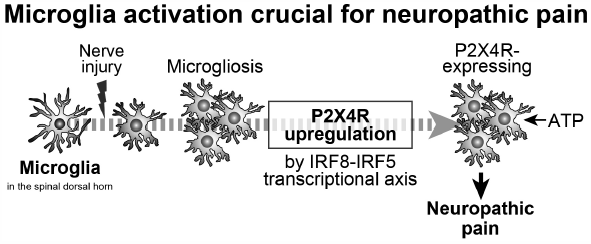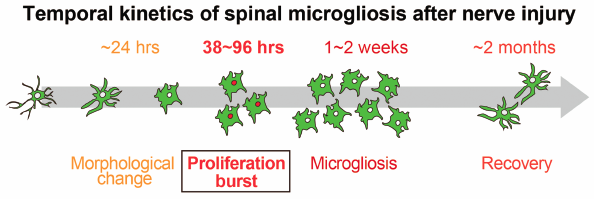- 著者
- Makoto Tsuda
- 出版者
- The Pharmaceutical Society of Japan
- 雑誌
- Biological and Pharmaceutical Bulletin (ISSN:09186158)
- 巻号頁・発行日
- vol.42, no.12, pp.1959-1968, 2019-12-01 (Released:2019-12-01)
- 参考文献数
- 132
- 被引用文献数
- 15 49
Pain is a defense system that responds rapidly to harmful internal and external stimuli through the somatosensory neuronal pathway. However, damage to the nervous system through cancer, diabetes, infection, autoimmune disease, chemotherapy or trauma often leads to neuropathic pain, a debilitating chronic pain condition. Neuropathic pain is not simply a temporal continuum of acute nociceptive signals from the periphery, but rather due to pathologically altered functions in the nervous system, which shift the net neuronal excitatory balance toward excitation. Although alterations were long thought to be a result of changes in neurons, but an increasing body of evidence over the past decades indicates the necessity and sufficiency of microglia, the tissue-resident macrophages of the spinal cord and brain, for nerve injury-induced malfunction of the nervous system. In this review article, I describe our current understanding of the molecular and cellular mechanisms underlying the role of microglia in the pathogenesis of neuropathic pain and discuss the therapeutic potential of microglia from recent advances in the development of new drugs targeting microglia.
1 0 0 0 OA Temporal Kinetics of Microgliosis in the Spinal Dorsal Horn after Peripheral Nerve Injury in Rodents
- 著者
- Keita Kohno Junko Kitano Yuta Kohro Hidetoshi Tozaki-Saitoh Kazuhide Inoue Makoto Tsuda
- 出版者
- The Pharmaceutical Society of Japan
- 雑誌
- Biological and Pharmaceutical Bulletin (ISSN:09186158)
- 巻号頁・発行日
- vol.41, no.7, pp.1096-1102, 2018-07-01 (Released:2018-07-01)
- 参考文献数
- 34
- 被引用文献数
- 33
Neuropathic pain, a highly debilitating chronic pain following nerve damage, is a reflection of the aberrant functioning of a pathologically altered nervous system. Previous studies have implicated activated microglia in the spinal dorsal horn (SDH) as key cellular intermediaries in neuropathic pain. Microgliosis is among the dramatic cellular alterations that occur in the SDH in models of neuropathic pain established by peripheral nerve injury (PNI), but detailed characterization of SDH microgliosis has yet to be realized. In the present study, we performed a short-pulse labeling of proliferating cells with ethynyldeoxyuridine (EdU), a marker of the cell cycle S-phase, and found that EdU+ microglia in the SDH were rarely observed 32 h after PNI, but rapidly increased to the peak level at 40 h post-PNI. Numerous EdU+ microglia persisted for the next 20 h (60 h post-PNI) and decreased to the baseline on day 7. These results demonstrate a narrow time window for rapidly inducing a proliferation burst of SDH microglia after PNI, and these temporally restricted kinetics of microglial proliferation may help identify the molecule that causes microglial activation in the SDH, which is crucial for understanding and managing neuropathic pain.

